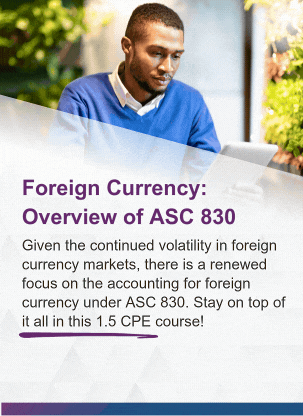
Unlock the Puzzle of Accounting for Foreign Currency (ASC 830)
Accounting for foreign currency under ASC 830 can be confusing. That’s why we published our Foreign Currency: Overview of ASC 830 eLearning course and our Foreign Currency Matters Accounting Topic Page. As part of launching our new website and updating this eLearning course in accordance with NASBA regulations, it got me thinking of one of my earliest posts on the topic. I wondered “what’s happened to FX rates since that post was originally published?” As such, I’ve updated this post talking about the accounting for foreign currency and the subsequent change in FX rates since its original publish date.

Introduction to foreign currency
On June 2, 2015 (the date of the original post), the EUR/USD rate was 1.11497. On March 20, 2018, when I updated the post for the first time, the EUR/USD rate was 1.22962. Now, on February 7, 2025, as you can see in the chart above the EUR/USD rate was 1.0332. This current rate means that if I want €1 for my European vacation I have to spend $1.03. Back in 2018, I had to spend $1.23 to get €1. My fellow Americans now is the time for that European vacation!
What impact does this have on business? American companies with European subsidiaries are not happy. Why? Their investment has decreased in value. However, if they’ve borrowed money in euros, the cost of funds, in USD terms, just got a whole lot cheaper. The opposite is true of European companies with American subsidiaries.
Confused? That’s not surprising.
Foreign currency is “foreign” to many Americans
According to this article, 64% of Americans do not hold a valid passport. This isn’t all that astonishing considering that, before I went on an international rotation to Switzerland with KPMG in 1998, I had only been outside the United States ONCE. Upon arrival in Europe, I was faced with a myriad of foreign currencies, as the euro had yet to be introduced. Even with my “cheat sheets,” foreign currency was just plain confusing.
Framework for ASC 830
Currency volatility has brought the accounting for foreign currency in accordance with ASC 830 back into the spotlight. In PwC’s Viewpoint, they lay out a six-step process for accounting for foreign currency under ASC 830:

We’ll use this framework to BRIEFLY walkthrough the requirements of ASC 830.
Step 1: Identify the reporting entity’s reporting currency.
This step is best explained using definitions found within ASC 830:
Reporting entity
An entity or group whose financial statements are being referred to. Those financial statements reflect any of the following:
- The financial statements of one or more foreign operations by combination, consolidation, or equity accounting; or
- Foreign currency transactions.
Reporting currency
The currency in which a reporting entity prepares its financial statements.
Step 2: Identify the reporting entity’s foreign entities.
The functional currency determination (Step 3) does not have to be made on a legal entity basis. Instead, ASC 830 discusses the concept of a foreign entity.
A foreign entity is a distinct and separable operation that is combined, consolidated or accounted for using the equity method of accounting and has a functional currency other than the reporting entity’s functional currency.
ASC 830-10-45-5 indicates an entity might have more than one distinct and separable operation, such as a division or branch, in which case each operation may be considered a separate foreign entity. If those operations are conducted in different economic environments, they might have different functional currencies.
Therefore, it is possible for a legal entity to have more than one functional currency, assuming it has several distinct and separable operations, each with different functional currencies.
To be considered “distinct and separable” most professional-service firms believe the entity should demonstrate all of the following conditions:
- Entity manages activities separately its other operations
- Assets and liabilities are distinguishable and are relevant to the operation’s activities.
- Operation is able to produce meaningful financial statements.
Step 3: Determine the functional currency of each foreign entity.
This step is key to accounting for foreign currency transactions and translations. It is important to determine the functional currency for each distinct and separable operation. This determination is based on facts. An entity does not choose its functional currency.
ASC 830-10-20 provides the following definition:
An entity’s functional currency is the currency of the primary economic environment in which the entity operates; normally, that is the currency of the environment in which an entity primarily generates and expends cash.
The determination of a foreign entity’s functional currency may be straightforward or may be quite complex, requiring significant judgment. ASC 830-10-55-5 provides various economic indicators to assist management in determining its functional currency.
Step 4: Measure foreign currency transactions.
ASC 830-10-20 defines foreign currency transactions as transactions whose terms are denominated in a currency other than the entity’s functional currency.
Foreign currency transactions are initially recorded by the entity in their functional currency. Subsequent accounting is as follows:
- Monetary assets and liabilities (e.g., accounts receivable and debt) are measured at the end of each reporting period based on current exchange rates. This measurement gives rise to foreign currency gains or losses, which are reported in net income.
- Nonmonetary assets and liabilities (e.g., PP&E and inventory) are initially measured using historical exchange rates and, therefore, do not give risk to foreign currency gains or losses.
Step 5: Translate financial statements of foreign entities.
The financial statements of foreign entities are in their functional currency. However, upon consolidation, they need to be reported in the reporting currency of the parent. This process is called foreign currency translation.
Gains and losses arising from translation are recorded in the cumulative translation adjustment (CTA) account. CTA is a separate component of accumulated other comprehensive income (OCI) found within shareholders’ equity.
Step 6: Evaluate whether CTA should be released into net income.
The gains and losses that are accumulated over time within the CTA account don’t stay there indefinitely. However, there are very specific rules as to when these gains and losses are released.
CTA is reclassified from equity to net income “upon sale or complete or substantially complete liquidation” of or “loss of control” over the foreign entity, depending on the situation.
Check out this blog for more information on foreign currency translation (steps 5 and 6).
Additional information is available
The information in this blog post was very high level. For additional information on accounting for foreign currency transactions and translations in accordance with ASC 830 Foreign Currency Matters check out our Foreign Currency Matters accounting topic page or contact us to discuss a tailored workshop for your organization. Interested in the effect of foreign currency on the cash flow statement? Check out this post.
About GAAP Dynamics
We’re a DIFFERENT type of accounting training firm. We view training as an opportunity to empower professionals to make informed decisions at the right time. Whether it’s U.S. GAAP, IFRS, or audit training, we’ve trained thousands of professionals since 2001, including at some of the world’s largest firms. Our promise: Accurate, relevant, engaging, and fun training. Want to know how GAAP Dynamics can help you? Let’s talk!
Disclaimer
This post is for informational purposes only and should not be relied upon as official accounting guidance. While we’ve ensured accuracy as of the publishing date, standards evolve. Please consult a professional for specific advice.

